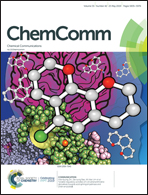Effect of scaffold structures on the artificial light-harvesting systems: a case study with an AIEE-active pillar[5]arene dyad†
Abstract
Artificial light-harvesting systems were assembled as nanoparticles by an AIEE-active pillar[5]arene dyad H1, a complimentary fluorescent ditopic guest G2, and an optically silent tritopic guest G1 in water with CTAB. The formation of H1–G1 supramolecular polymers enhanced the G2 emission and the H1–G2 energy transfer, confirming the importance of scaffold structures in the systems.
![Graphical abstract: Effect of scaffold structures on the artificial light-harvesting systems: a case study with an AIEE-active pillar[5]arene dyad](/en/Image/Get?imageInfo.ImageType=GA&imageInfo.ImageIdentifier.ManuscriptID=C9CC02585E&imageInfo.ImageIdentifier.Year=2019)


 Please wait while we load your content...
Please wait while we load your content...